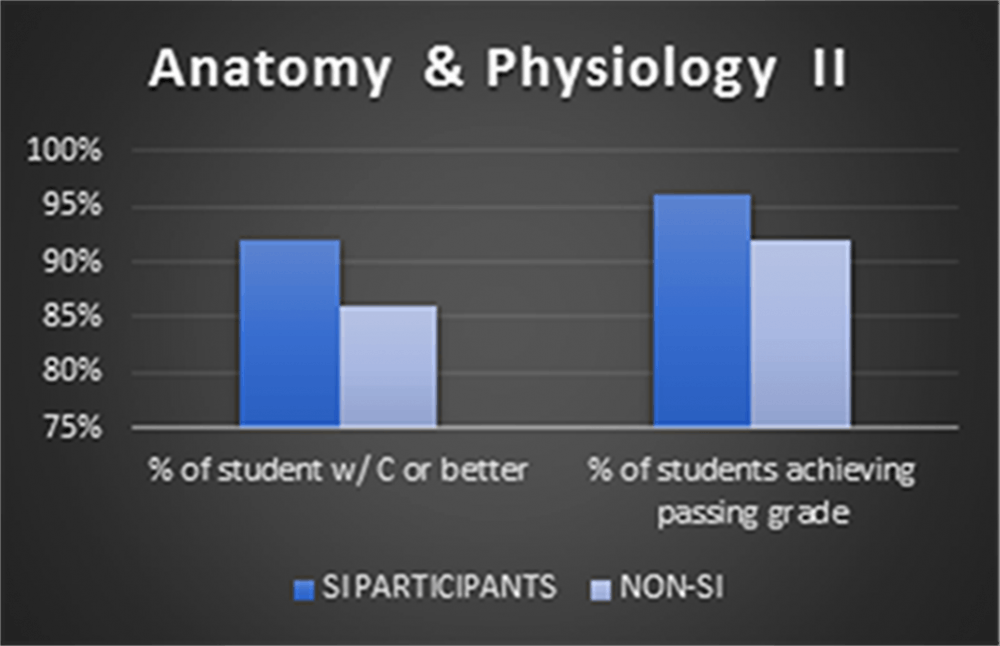With the semester nearing a close, many students are feeling the looming pressure of exams and final grades. Sometimes the best way to combat these pressures is with the help of other students.
In some courses, Seton Hall offers Supplemental Instruction. Supplemental Instruction courses are student-run to help others in the class study and prepare for exams. Students who have taken specific courses such as Anatomy and Physiology or Pathophysiology and performed well in those courses, are asked to become Supplemental Instruction (SI) leaders for those courses the next semester that they are offered.
[caption id="attachment_18987" align="aligncenter" width="838"] Students in Supplemental Instruction courses tend to earn higher grades than others. Graphic courtesy of Brandon Larmore.[/caption]
These SI student-leaders must do well in the specific course, have attended an SI session, attend an interview with the current SI leader and attend an interview with Brandon Larmore, director of the Academic Resource Center and coordinator of the SI Program. From there, students who have gone through this training can become SI leaders.
Supplemental instruction courses run twice a week for roughly an hour at a time. SI leaders strive to keep studying fun and engaging for students. Larmore highlighted the uniqueness of the program. Students often rely on intrinsic motivation.
“It forces students to actually participate in [the] entire process,” Lamore said. “It helps engage them better with the material by putting the onus not on the tutor or the Supplemental Instruction leader, but on the students themselves. When students come to an SI session, they should expect to do work.”
In the Fall of 2017, SI sessions will be held in General Biology I, General Chemistry I, Anatomy & Physiology I, and Pathophysiology. Larmore stressed that students who are interested in recommending courses for Supplemental Instruction reach out to him.
SI leaders meet and discuss course material with professors to ensure they are updated on course material. SI leaders have a set of structured activities prepared for each session, such as Verbal Volleyball, Family Feud, or Jeopardy in which students interact with each other to help prepare them for their tests, but also studying on their own. These leaders can refresh their own skills while helping other students.
Kevin Lopes, a junior nursing major and SI leader explained the advantages and disadvantages of SI instruction.
“I’ve personally sat through the same material that they are covering, I know what parts are going to be more difficult topics for them to understand, and that way I can make sure I cover that more thoroughly during the session, Lopes said.
He added that the only disadvantage is when he has a busy week, sometimes there is a time crunch to fit in and prepare his lesson plans.
Maria Provenzano, a sophomore nursing major, expressed how SI differs from an average tutoring session.
“It’s not as intimidating. It’s more comfortable asking a peer questions compared to a professor,” she said. “It is the best decision I’ve made to further my academics.”
Erika Szumel can be reached at erika.szumel@student.shu.edu.
Students in Supplemental Instruction courses tend to earn higher grades than others. Graphic courtesy of Brandon Larmore.[/caption]
These SI student-leaders must do well in the specific course, have attended an SI session, attend an interview with the current SI leader and attend an interview with Brandon Larmore, director of the Academic Resource Center and coordinator of the SI Program. From there, students who have gone through this training can become SI leaders.
Supplemental instruction courses run twice a week for roughly an hour at a time. SI leaders strive to keep studying fun and engaging for students. Larmore highlighted the uniqueness of the program. Students often rely on intrinsic motivation.
“It forces students to actually participate in [the] entire process,” Lamore said. “It helps engage them better with the material by putting the onus not on the tutor or the Supplemental Instruction leader, but on the students themselves. When students come to an SI session, they should expect to do work.”
In the Fall of 2017, SI sessions will be held in General Biology I, General Chemistry I, Anatomy & Physiology I, and Pathophysiology. Larmore stressed that students who are interested in recommending courses for Supplemental Instruction reach out to him.
SI leaders meet and discuss course material with professors to ensure they are updated on course material. SI leaders have a set of structured activities prepared for each session, such as Verbal Volleyball, Family Feud, or Jeopardy in which students interact with each other to help prepare them for their tests, but also studying on their own. These leaders can refresh their own skills while helping other students.
Kevin Lopes, a junior nursing major and SI leader explained the advantages and disadvantages of SI instruction.
“I’ve personally sat through the same material that they are covering, I know what parts are going to be more difficult topics for them to understand, and that way I can make sure I cover that more thoroughly during the session, Lopes said.
He added that the only disadvantage is when he has a busy week, sometimes there is a time crunch to fit in and prepare his lesson plans.
Maria Provenzano, a sophomore nursing major, expressed how SI differs from an average tutoring session.
“It’s not as intimidating. It’s more comfortable asking a peer questions compared to a professor,” she said. “It is the best decision I’ve made to further my academics.”
Erika Szumel can be reached at erika.szumel@student.shu.edu.

Comments




